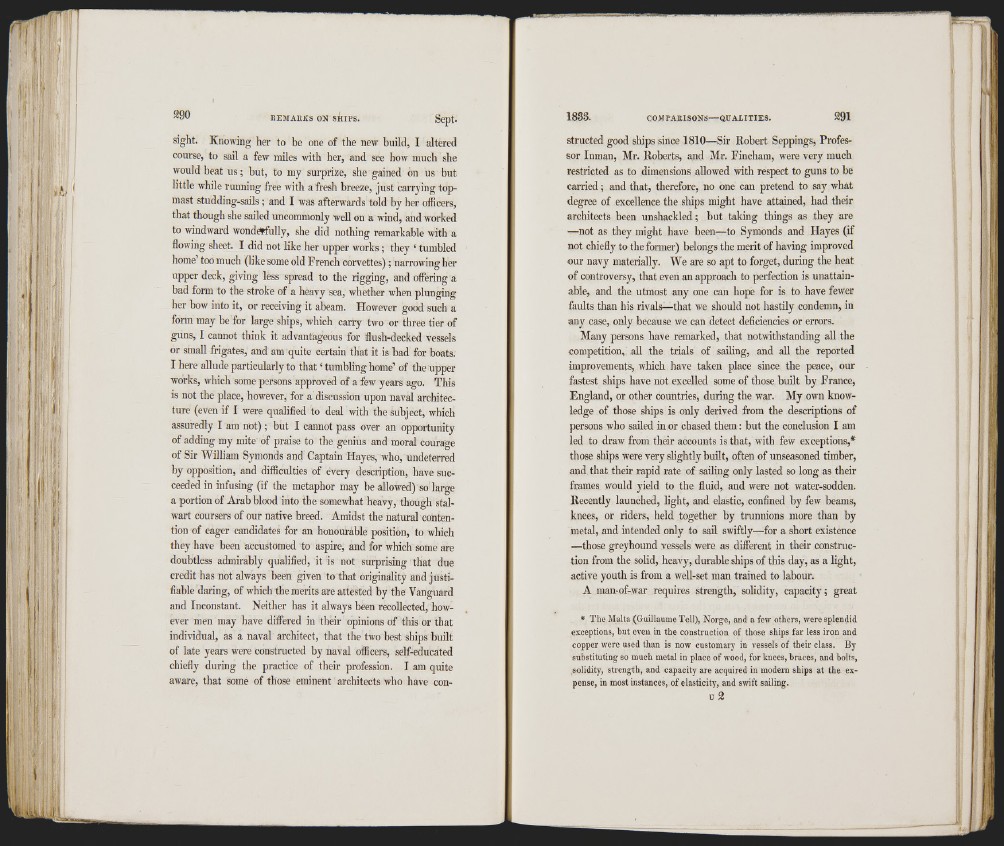
> .
-í-
, ■) 1 ' '
' I
J!
I:
'■li
ll !
: Í
sight. Knowing her to he one of the new huild, I altered
course, to sail a few miles with her, and see how much she
would heat u s ; hut, to my surprize, she gained on us hut
little while running free with a fresh hreeze, just carrying topmast
studding-sails ; and I was afterwards told hy her officers,
that though she sailed uncommonly well on a wind, and worked
to windward wondeKfully, she did nothing remarkable with a
flowing sheet. I did not like her upper works; they ‘ tumbled
home’ too much (like some old French corvettes) ; narrowing her
upper deck, giving less spread to the rigging, and offering a
bad form to the stroke of a heavy sea, whether when plunging
her bow into it, or receiving it abeam. However good such a
form may be for large ships, which carry two or three tier of
guns, I cannot think it advantageous for flush-decked vessels
or small frigates, and am quite certain that it is bad for boats.
I here allude particularly to that ‘ tumbling home’ of the upper
works, which some persons approved of a few years ago. This
is not the place, however, for a discussion upon naval architecture
(even if I were qualified to deal with the subject, which
assuredly I am not) ; but I cannot pass over an opportunity
of adding my mite of praise to the genius and moral courage
of Sir William Symonds and Captain Hayes, who, undeterred
by opposition, and difficulties of every description, have succeeded
in infusing (if the metaphor may he allowed) so large
a portion of Arab blood into the somewhat heavy, though stalwart
coursers of our native breed. Amidst the natural contention
of eager candidates for an honourable position, to which
they have been accustomed to aspire, and for which some are
doubtless admirably qualified, it is not surprising that due
credit has not always been given to that originality and justifiable
daring, of which the merits are attested by the Vanguard
and Inconstant. Neither has it always been recollected, however
men may have differed in their opinions of this or that
individual, as a naval architect, that the two best ships built
of late years were constructed by naval officers, self-educated
chiefly during the practice of their profession. I am quite
aware, that some of those eminent architects who have con1833.
structed good ships since 1810—Sir Robert Seppings, Professor
Inman, Mr. Roberts, and Mr. Fincham, were very much
restricted as to dimensions allowed with respect to guns to he
carried ; and that, therefore, no one can pretend to say what
degree of excellence the ships might have attained, had their
architects been unshackled ; but taking things as they are
—not as they might have been—to Symonds and Hayes (if
not chiefly to the former) belongs the merit of having improved
our navy materially. We are so apt to forget, during the heat
of controversy, that even an approach to perfection is unattainable,
and the utmost any one can hope for is to have fewer
faults than his rivals—that we should not hastily condemn, in
any case, only because we can detect deficiencies or errors.
Many persons have remarked, that notwithstanding all the
competition, all the trials of sailing, and all the reported
improvements, which have taken place since the peace, our
fastest ships have not excelled some of those built by France,
England, or other countries, during the war. My own knowledge
of those ships is only derived from the descriptions of
persons who sailed in or chased them : but the conclusion I am
led to draw from their accounts is that, with few exceptions,*
those ships were very slightly built, often of unseasoned timber,
and that their rapid rate of sailing only lasted so long as their
frames would yield to the fluid, and were not water-sodden.
Recently launched, light, and elastic, confined by few beams,
knees, or riders, held together by trunnions more than by
metal, and intended only to sail swiftly—for a short existence
—those greyhound vessels were as different in their construction
from the solid, heavy, durable ships of this day, as a light,
active youth is from a well-set man trained to labour.
A man-of-war requires strength, solidity, capacity ; great
* The Malta (Guillaume Tell), Norge, and a few others, were splendid
exceptions, but even in the construction of those ships far less iron and
copper were used than is now customary in vessels of their class. By
substituting so much metal in place of wood, for knees, braces, and bolts,
solidity, strength, and capacity are acquired in modei*n ships at the expense,
in most instances, of elasticity, and swift sailing.
U 2